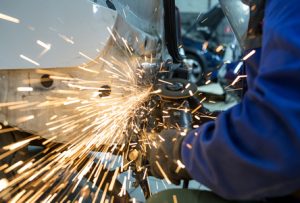[breadcrumb]
How Can a Metal Machine Worker Get Mesothelioma by Occupational Exposure to Asbestos?
Metal machine workers set up and operate machines that cut, shape and form metal pieces. Their job may require them to complete various tasks associated with metal, including fabricating, welding and installing metal pieces.
Metal machine workers typically work in factories, machine shops and steel mills, all of which are associated with high levels of asbestos in the past. Many of these locations were built with asbestos-containing construction materials, such as insulation that was sprayed on metal beams and other frameworks. Asbestos was also included in wraps for boilers and paper and insulation that was used to wrap electrical wires and steam pipes. Because asbestos was resistant to heat and fire, it was commonly used in environments that required high temperatures to produce their products.
Additionally, metal machine workers may have worked in direct contact with asbestos for the products they were making, such as welding rods they used to join metals together. Asbestos particles often become dislodged during grinding, drilling and sanding activities. Constant contact with asbestos dust and fibers placed many metal workers at an increased risk of developing asbestos diseases like mesothelioma and asbestosis.
Another potential source of exposure was the protective gear that metal workers wore, which often contained asbestos. This protective clothing included aprons, gloves and masks.
Common job duties of metal machine workers include the following:
- Use blueprints to set up machines
- Monitor machines for unusual sounds or vibrations
- Operate metal molding, casting or coremaking machines
- Insert material into machines
- Adjust machine settings
- Test and compare finished pieces to specifications
Remove and replace cutting tools
Locations in the United States for the Highest Employment Rates for Metal Machine Workers
According to the U.S. Bureau of Labor Statistics, there are 1,073,900 metal and plastic machine workers currently employed in the United States. States with the highest employment level for this classification include:
- Ohio
- Illinois
- Michigan
- Texas
- Pennsylvania
Similar Occupations as Metal Machine Workers
Similar occupations as metal machine workers include:
- Assemblers and fabricators
- Computer programmers
- Industrial machinery mechanics
- Machinery maintenance workers
- Machinists
- Machinists and tool and die makers
- Millwrights
- Painting and coating workers
- Press machine setters, operators and tenders
Lawsuits and Settlements Involving Metal Machine Workers and Mesothelioma
Metal workers have sometimes filed lawsuits after being diagnosed with asbestos-related diseases such as mesothelioma. The family of a former steel worker who worked in a steel meal in Reading, Pennsylvania received an award of $2 million against Oglebay Norton, Co., which the jury found negligent in manufacturing its asbestos-containing products.
A sheet metal worker who worked at Longbeach Naval Shipyard received an award against Owens-Illinois, Inc. in 1995 brought a case that was later used as precedent for future asbestos lawsuits and shifted the burden of proof onto defendants.
A metalsmith for the U.S. Navy was awarded $21 million against multiple manufacturers of asbestos-containing manufacturers of gaskets, valves and insulation products that the Navy used.
Metal machine workers who have been exposed to asbestos may have a variety of options to receive compensation for the damages that they sustained, including filing a workers’ compensation claim, personal injury lawsuit or asbestos bankruptcy trust fund claim.
Studies Related to Metal Machine Workers and Asbestos
There have been a few studies that have linked metal working and asbestos exposure. A 2017 study of approximately 13,000 welders found that these workers had an elevated risk for lung cancer, mesothelioma and bladder cancer. The Center for Construction Research and Training and the Sheet Metal Occupational Health Institute Trust concluded that sheet metal workers were at a high risk of developing mesothelioma, especially if they were working in the industry before asbestos regulations were in place. Researchers by the Sheet Metal Occupational Health Institute Trust found that 32% of union workers in the sheet metal industry between 1986 and 1990 had specific lung abnormalities associated with occupational lung diseases.
However, in “Asbestos disease in sheet metal workers: the results of a proportional mortality analysis,” researchers found that there were not excessive levels of cancer related to asbestos exposure for those workers who worked only intermittently around asbestos.
The Occupational Health Program of Montefiore Medical Center and the Albert Einstein College of Medicine conducted a study in 1982 and found that New York City sheet metal workers who worked in building construction were exposed to asbestos at dangerous levels. The primary form of exposure was from spray-on asbestos insulation.
Types of Asbestos Products Used by Metal Machine Workers
Metal machine workers may have worked with products that contained asbestos, such as:
- Asbestos cement
- Fireproofing aprons
- Fireproofing blankets
- Insulation
- Gaskets and valves
- Gloves
- Metal sheets
- Metal tools
- Paint
- Welding rods
Manufacturers of Asbestos Products Used by Metal Machine Workers
Some of the most notable asbestos manufacturers that may have been responsible for exposing metal machine workers to asbestos include:
- Bath Iron Works
- BF Goodrich
- CertainTeed Corporation
- Duro Dyne Corporation
- Garlock Sealing Technologies
- Halliburton
- Honeywell
- Johns Manville
- Metalclad Insulation Company
- Pneumo Abex
- Raybestos
- Turner & Newall

